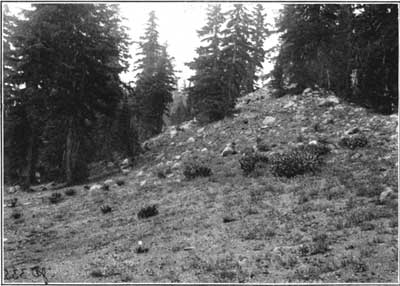Geological History of Crater Lake
In addition to the strong contrast between the outer and inner slopes of the rim the map shows the occurrence of a number of small cones upon the outer slope of the great cone. These adnate cones are of peculiar significance when we come to consider the volcanic rocks of which the region is composed. The rim is ribbed by ridges and spurs radiating from the lake, and the bead of each spur is marked by a prominence on the crest of the rim. The variation in the altitude of the rim crest is 1,456 feet (from about 6,700 at Kerr Notch to 8,156 feet at Glacier Peak) with seven points rising above 8,000 feet. The crest generally is passable, so that a pedestrian may follow it continuously around the lake, with the exception of short intervals about the notches in the southern side. At many points the best going is on the inner side of the crest, where the open slope, generally well marked with deer trails over beds of pumice, affords an unobstructed view of the lake.

Reference has already been made to the glacial phenomena of the outer slope of the rim. There are scattered bowlders upon the surface, and also in piles of glacial moraine (fig. 9), which contain besides bowlders much gravel and sand. Such glacial drift is spread far and wide over the southern and western portion of the rim, extending down the watercourses in some cases for miles to broad plains, through which the present streams have carved the deep and picturesque canyons already observed on the ascent. At many points the lavas are well rounded, smoothed, and striated by glacial action. This is true of the ridges as well as of the valleys, and the distribution of these marks is coextensive with that of the glacial detritus.

